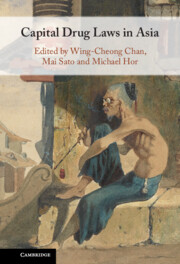Refine search
Actions for selected content:
357 results
4 - The New Taphonomy and How It Can Boost the Role of the Asian Pleistocene Archaeological Record in Human Evolution
-
-
- Book:
- Traces of the Distant Human Past
- Published online:
- 13 December 2025
- Print publication:
- 22 January 2026, pp 214-250
-
- Chapter
- Export citation
3 - International Commercial Alternative Dispute Resolution in Asia
- from Part I - Commercial Law
-
-
- Book:
- Inter-Asian Law
- Published online:
- 16 December 2025
- Print publication:
- 22 January 2026, pp 57-79
-
- Chapter
-
- You have access
- Open access
- HTML
- Export citation
Chapter 13 - The Changing View of the United States
- from Part III - Political Guardianship Psychology and Foreign Attitudes
-
- Book:
- The Political Psychology of Citizens in Rising China
- Published online:
- 04 December 2025
- Print publication:
- 08 January 2026, pp 371-393
-
- Chapter
- Export citation
Chapter 11 - Public Perceptions of the Influence of China’s Rise
- from Part III - Political Guardianship Psychology and Foreign Attitudes
-
- Book:
- The Political Psychology of Citizens in Rising China
- Published online:
- 04 December 2025
- Print publication:
- 08 January 2026, pp 311-342
-
- Chapter
- Export citation
Chapter 12 - Nationalist and International Orientations
- from Part III - Political Guardianship Psychology and Foreign Attitudes
-
- Book:
- The Political Psychology of Citizens in Rising China
- Published online:
- 04 December 2025
- Print publication:
- 08 January 2026, pp 343-370
-
- Chapter
- Export citation
A major city of the Kazakh Steppe? Investigating Semiyarka’s Bronze Age legacy
-
- Journal:
- Antiquity , First View
- Published online by Cambridge University Press:
- 18 November 2025, pp. 1-9
-
- Article
-
- You have access
- Open access
- HTML
- Export citation
The westernmost Bronze Age oasis settlement in the Tarim Basin: excavating at the Aketala sites
-
- Journal:
- Antiquity , First View
- Published online by Cambridge University Press:
- 12 November 2025, pp. 1-8
-
- Article
-
- You have access
- HTML
- Export citation
Expanding the corpus of the earliest Scythian animal-style artefacts
-
- Article
-
- You have access
- Open access
- HTML
- Export citation
Chapter 34 - The Mongol Empire
- from Asia and the Americas
-
-
- Book:
- The Cambridge Guide to Global Medieval Travel Writing
- Published online:
- 03 October 2025
- Print publication:
- 02 October 2025, pp 605-622
-
- Chapter
- Export citation
Chapter 9 - Ibn Battuta
- from Part I - Contexts
-
-
- Book:
- The Cambridge Guide to Global Medieval Travel Writing
- Published online:
- 03 October 2025
- Print publication:
- 02 October 2025, pp 165-180
-
- Chapter
- Export citation
Contested Modernities in Asian Law and Society: Editor’s Introduction to the Special Issue
-
- Journal:
- Asian Journal of Law and Society , First View
- Published online by Cambridge University Press:
- 01 October 2025, pp. 1-4
-
- Article
-
- You have access
- Open access
- HTML
- Export citation
Fellhaneropsis sigmoidea sp. nov. (Byssolomataceae, lichenized Ascomycota), a new foliicolous species from China, with a world key to the species of the genus Fellhaneropsis
-
- Journal:
- The Lichenologist / Volume 57 / Issue 5 / September 2025
- Published online by Cambridge University Press:
- 20 October 2025, pp. 200-205
- Print publication:
- September 2025
-
- Article
- Export citation
Chapter 2 - Attitudes toward Competition in Asian and Western Societies from the Late 1980s to the Early 2020s
-
-
- Book:
- Questioning Conventional Assumptions of Competition Dynamics
- Published online:
- 07 May 2025
- Print publication:
- 21 August 2025, pp 16-57
-
- Chapter
- Export citation
Chapter 18 - Studies of Asia and Australia’s engagement with Asia
- from Part IV - Integration across cross-curriculum priorities
-
-
- Book:
- Making Humanities and Social Sciences Come Alive
- Published online:
- 02 August 2025
- Print publication:
- 14 August 2025, pp 302-320
-
- Chapter
- Export citation
17 - Researching English Medium Instruction (EMI) in Asian Higher Education
- from Part III - Teaching Academic Subjects through English Medium Instruction
-
-
- Book:
- The Cambridge Handbook of Multilingual Education
- Published online:
- 25 December 2025
- Print publication:
- 14 August 2025, pp 327-342
-
- Chapter
- Export citation
18 - EMI
- from Part III - Teaching Academic Subjects through English Medium Instruction
-
-
- Book:
- The Cambridge Handbook of Multilingual Education
- Published online:
- 25 December 2025
- Print publication:
- 14 August 2025, pp 343-360
-
- Chapter
- Export citation
Classifying Asian party systems: Sartori’s typology in comparative perspective
-
- Journal:
- Italian Political Science Review / Rivista Italiana di Scienza Politica , First View
- Published online by Cambridge University Press:
- 08 August 2025, pp. 1-9
-
- Article
-
- You have access
- Open access
- HTML
- Export citation

Capital Drug Laws in Asia
-
- Published online:
- 07 August 2025
- Print publication:
- 24 July 2025
Chapter 3 - The Arts and cross-curriculum priorities
- from Part 1 - Why: the arts in education and society
-
- Book:
- Teaching the Arts
- Published online:
- 28 July 2025
- Print publication:
- 06 August 2025, pp 64-100
-
- Chapter
- Export citation
Pulei Cave: the first Palaeolithic cave site found in the Eastern Tianshan Mountains of Xinjiang
-
- Article
-
- You have access
- Open access
- HTML
- Export citation
